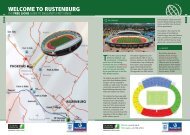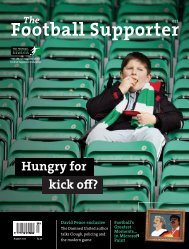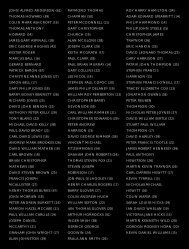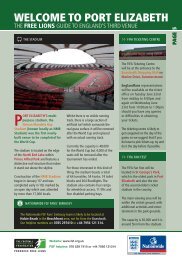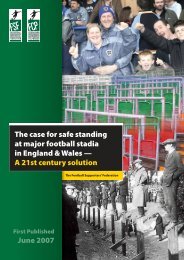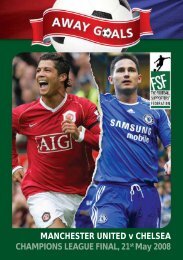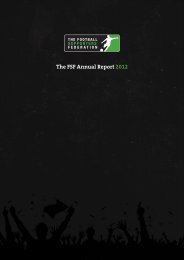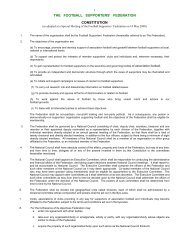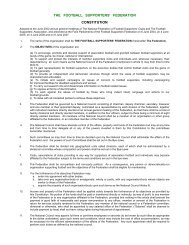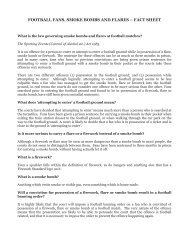Taylor Report - South Yorkshire Police
Taylor Report - South Yorkshire Police
Taylor Report - South Yorkshire Police
Create successful ePaper yourself
Turn your PDF publications into a flip-book with our unique Google optimized e-Paper software.
He referred to the argument of Counsel for the <strong>South</strong> <strong>Yorkshire</strong> <strong>Police</strong> as follows:-<br />
"Thirdly, here the police were not discharging their own duty to the public; they were in fact discharging the<br />
Club's duties to the spectators whom the Club invited to the ground. The Club chose to invite large numbers<br />
to their private premises; it was the Club's duty to provide for their safety, health and comfort. They could<br />
have employed a security firm as banks and others have to do to protect their interests; they chose to request<br />
the police to perform those duties knowing that the police expected payment. Fourthly, the police within the<br />
ground provided services which it was not within the scope of their public duty to perform. For instance,<br />
they assisted in crowd management and in the enforcement of such ground regulations as refused entry to<br />
those who tried to enter without paying or prohibited spectators encroaching on parts of the ground which<br />
their entry fee did not entitle them to enter. It may be, submits Mr Bentley, that the maintenance of law and<br />
order was the predominant aim but there were other services performed."<br />
The learned Judge found:-<br />
"In addition to what may be called their law and order role the police were expected and did take part in<br />
crowd management, ensuring the safety of spectators, the enforcement of the Club's regulations and to be on<br />
hand to assist in the event of some emergencies such as fire or accidental injury."<br />
<strong>Police</strong> Practice at the Leppings Lane End<br />
170. At League matches at Hillsborough, the police practice was to decide in advance how many and which<br />
pens would be used. If a modest crowd was anticipated only one or two pens might be needed. It was better to<br />
confine the fans to limited spaces (a) to prevent them running about and (b) to reduce the number of police<br />
required. The practice was then to fill the pens one by one. This involved making a judgement as to when a pen<br />
was full. There would then be a police decision to close that pen and fill another. It was regarded as impractical<br />
and unsafe for police officers (just like stewards) to go onto the Leppings Lane terraces with away supporters.<br />
This meant that monitoring the numbers in any pen had to be done from vantage points outside it. Here, the<br />
police were much better placed than the stewards. There was a good view from the control box and the<br />
television screens there. There were officers on the perimeter track. No stewards were placed there because<br />
having both police and stewards interfered with the viewing. There were also police in the west stand who<br />
could look down on the pens. Intelligence from all these sources could give the police a good appreciation of<br />
the state of the terraces. When it was necessary to shut off access to the pens officers on the concourse could be<br />
informed by radio and could take the necessary steps.<br />
"Find Their Own Level"<br />
171. At Cup semi-finals, a different approach was adopted. All the pens were opened from the start and the<br />
policy was "to let the fans find their own level". This phrase was repeated again and again by police officers at<br />
the Inquiry. What it meant was that no specific direction was given to fans entering through the turnstiles.<br />
They were free to go wherever they wished on the terraces. If they became uncomfortable or wished for any<br />
other reason to move their position, then theoretically they could move elsewhere. In this way it was hoped that<br />
the fans on the terraces would level themselves out and that distribution would be achieved without police<br />
intervention. On these occasions, the gates at the top of the radial fences were locked in the open position. It<br />
was sought to argue, therefore, that there was freedom of movement from one pen to another enabling fans to<br />
"find their level".<br />
172. This argument was bad both in theory and in practice. In theory, the whole object of the radial fences<br />
had been to achieve even distribution by directing fans into desired positions. To say then that they could move<br />
freely from one pen to another would defeat the object and enable fans to go from a less popular to a more<br />
popular area without inhibition. In practice this did not happen because the position and size of the gates was<br />
such that once a substantial number of spectators were in, the gates were unnoticeable and inaccessible<br />
especially to those towards the front who might have most need of them.<br />
173. The same argument was deployed to suggest that individual maximum capacities for individual pens<br />
need not be assessed since the presence of the open radial gates still meant that the terrace was one area. In<br />
practice this simply was not so. The photograph at Appendix 5 taken from the north stand at 2.59 pm shows<br />
very clearly the congestion in pens 3 and 4 contrasted with the sparseness in pen 6. This gives the lie to the<br />
suggestion that the fans could, if uncomfortable, "find their own level".<br />
174. The effect of this policy was that whereas at League matches the police had to make a positive decision<br />
when to close one pen and open another, at semi-finals, where overcrowding was much more likely, the police<br />
30



